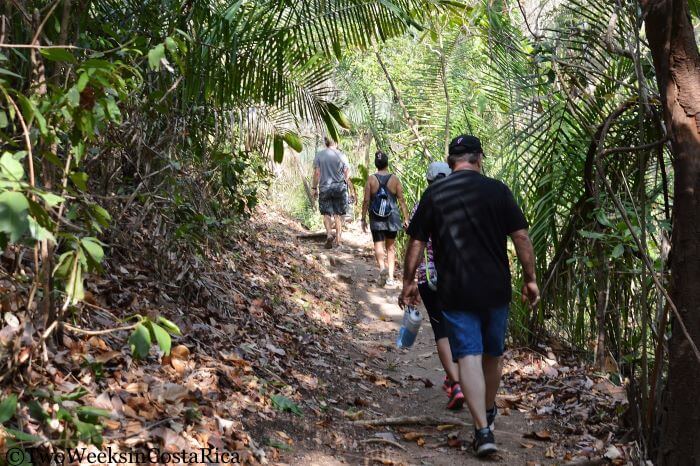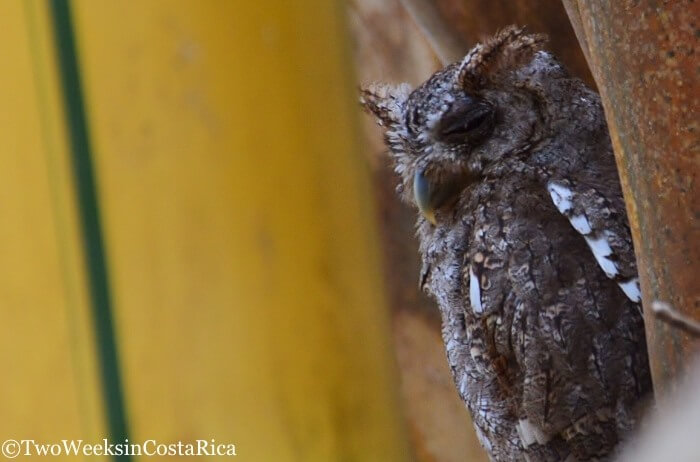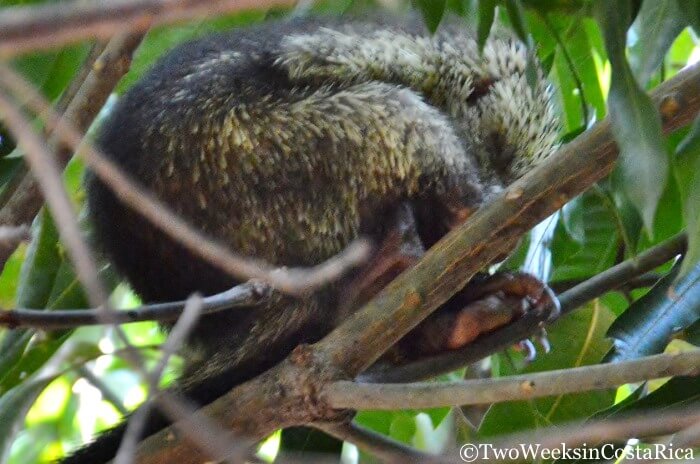The town of Samara in Costa Rica’s Guanacaste region is probably best known for being a chilled-out beach destination. But in the hills above the sand-sprinkled streets is an amazing nature experience waiting to be had. If you are up for some moderately difficult hiking, a visit to Samara Trails’ Werner-Sauter Biological Reserve is an activity you won’t want to miss. In this post, we’ll tell you why this protected swath of tropical dry forest is so important and let you know how to plan your visit.

About the Werner-Sauter Biological Reserve
The Werner-Sauter Biological Reserve is a 140 hectare (346 acre) private reserve that was once a family farm. As was typical for the region, they grew sugarcane and mangoes and also had cattle and horses. During Costa Rica’s environmental movement in the 1970s and 80s, large sections of the country’s rainforest and cloud forest were being protected. Nothing was being done for the tropical dry forest, however. Concerned about the future of this rich and important ecosystem, the family began to turn their working farm back into the natural forest that existed centuries earlier. Some 30 years later, the land is making great progress regenerating and is attracting a plethora of wildlife in the process.
Today, the family’s next generation has opened up the reserve to visitors. About five years ago, Alvaro Teran, a grandson of the original owners, cut some trails on the property and started Samara Trails. He began offering guided tours about the natural history of the area and the local flora and fauna. Now other guides have joined in to help him. Alvaro also started the Not Gone Yet Project. This is an effort to replace mango trees and other remnants of the old farm with endangered hardwoods native to Costa Rica (more on this at the end of the post).
The Trails
Our adventure at the Werner-Sauter Reserve began with our guide, Hanzel, enthusiastically jumping out of the van and gathering our small group in a circle. He was working quickly to get us started, trying to beat the heat, which would creep into the mid-90s F (mid-30s C) later in the day. Looking around, there wasn’t anything overly impressive about the surrounding forest. In fact, it looked rather dry and desolate. Leaves littered the ground, and because it was the very end of the dry season (April), many of the trees were naked from the lack of rain.
Within minutes, however, Hanzel was changing everyone’s perspective. Without walking more than a few steps, he pointed out a group of sac-winged bats perched under a thatched roof. These bats, he explained, fed mostly on insects. Minutes later, Hanzel was showing us a family of Pacific-screech Owls, including a baby, hiding in some bamboo.

The tour continued into the woods, eventually up some steep paths to a series of lookouts. Along the way, Hanzel taught us about some of the special trees growing beside the trail. We saw a balsa, used in shipbuilding, and then a rosewood, which is ideal for furniture and instrument making. Hanzel explained that these and other trees are somewhat rare in the area because they had been heavily logged for their lumber over the years.
We also saw a lot of wildlife thanks to our guide’s sharp eyes. Howler monkeys, birds like the Turquioise-browed Motmot and Long-tailed Manakin, and even some sleeping tropical porcupines, were a few of the highlights.

The best part of the fairly difficult hike, in our opinion, was the two viewpoints. The first one appeared to show nothing more than a nice view of the forest below, but we learned something really important. In the distance just beyond the border of the reserve was a gigantic teak tree plantation of almost 1,600 hectares (4,000 acres). These trees, native to India, were set in neat rows with nothing growing in between them. Apparently the leaves of teak are filled with tannins that local fungi and bacteria can’t break down. This essentially creates a stifling blanket of leaves on the ground that prevents any other plant species from growing. Even from far away we could see right through the rows of trees to the ground beneath.
In stark contrast, Hanzel pointed out that the land within the reserve was thick with different layers of vegetation. Many of the taller trees had lost their leaves because of the dry season, but a whole different layer of plants was growing underneath. And it was that shrubby layer that was preventing erosion and providing food and habitat for all the animals we saw. Hanzel then asked us how many porcupines and monkeys we thought lived in the neighboring teak forest, leaving us to ponder the importance of the reserve as we continued up hill.

A few minutes later, we reached the second and final viewpoint. This was the scenic viewpoint that we had been picturing. From 205 meters (672 feet) above sea level, we had a bird’s eye view of the sweeping Pacific Ocean. We could even see the beaches of Samara and Carrillo far below, separated by a wide point. With resting benches and a nice breeze off the ocean, the whole group really enjoyed spending some time at this lookout.

Trail Conditions
The 5.5 km (3.4 mile) hike getting to this point was fairly strenuous. The trails were in good condition during our visit, but there were some rocks, roots, and rustic steps to navigate. We would categorize the hike as moderately difficult, mostly because of the intense heat, but also because there are some steep stretches leading to the viewpoints. In our group, there was a couple in their early 60s, another in their 50s, and Jenn and me with our five-month old in the baby carrier. We all did fine overall, but one of the couples needed to take frequent breaks during the climb up because of the heat. We would recommend this hike only to those who are conditioned for moderate hiking as even an easy hike is fairly difficult in hot weather. Even though it was a tough hike, everyone agreed by the time we made it to the viewpoint that it was well worth the effort.
What to Bring
- Sun protection: A hat and sunscreen. This is especially important during the dry season (December-April) when there isn’t much shade.
- Insect repellant: Even though it was dry during our visit, we did encounter some mosquitoes on the trail. We like natural options like these, but Deet products and those containing Picaridin are also very effective.
- Hiking boots, good gripping sneakers, or hiking sandals like Keens.
- A large bottle of water (1 liter per person recommended) or Camelbak. Samara Trails provides a small bottle of water and drinks for afterwards, but you will need more during the hike.
- The oldest couple was prepared with a pouch of ice and some facecloths to share, which turned out to be a great way to keep baby Sam and everyone else cool. For the rest of our trip, we used our dry bag as an ice bag, which worked out great because it kept things cooler and didn’t leak.
- Camera and/or Binoculars
Tour Information
Tours are 2-3 hours and can be booked through Samara Trails. They offer a morning (7:00 a.m.) and afternoon (3:00 p.m.) tour, which includes a guide, hotel pickup, and drinks and snacks (we had cookies and fresh fruit).
Price: $40 Adults, $30 Children 12 and under. Minimum of 2 people.
Those wishing to further contribute to the Not Gone Yet reforestation project can do so by buying a Samara Trails T-shirt. The designs are pretty cool and doing so sponsors the planting of a native and endangered tree in your name. T-shirts are available at the Samara Adventure Company tour office in downtown Samara for $30. Alvaro will email you the details about your tree after you make the purchase. Here is a picture of the Ron Ron tree that we sponsored for Sam!

* * *
If you are looking for a challenging hike and some nature exploration during your stay in Samara, we highly recommend the Werner-Sauter Biological Reserve through Samara Trails. We learned so much about the tropical dry forest and it really made us appreciate this particular area of Costa Rica even more.
Special thanks to Samara Trails for hosting us on the tour. As always, all opinions are our own.
Have you ever hiked through the tropical dry forest? Let us know what you saw in the comments below.
Looking for more information to help plan your trip? Read these posts:
- Packing for Costa Rica – We covered some helpful items you might want for this hike but this post gives you all the essentials for your visit to Costa Rica.
- Costa Rica Wildlife Guides: Our Picks – Are you the type who wants to know specifically what type of monkey or bird you are seeing out on the trail? Check out these carry-along field guides that can slip right into your day pack.
- A Taste of Costa Rica: 7 Traditional Foods to Try – Costa Rican cuisine can be as diverse as the forest. Check out these seven traditional dishes that you should try on your vacation here.

